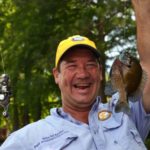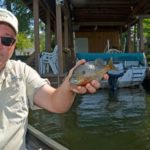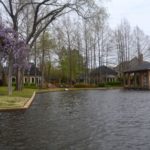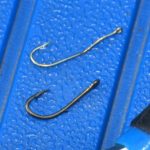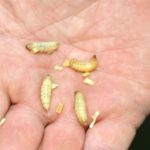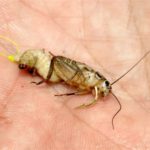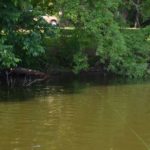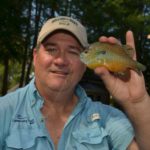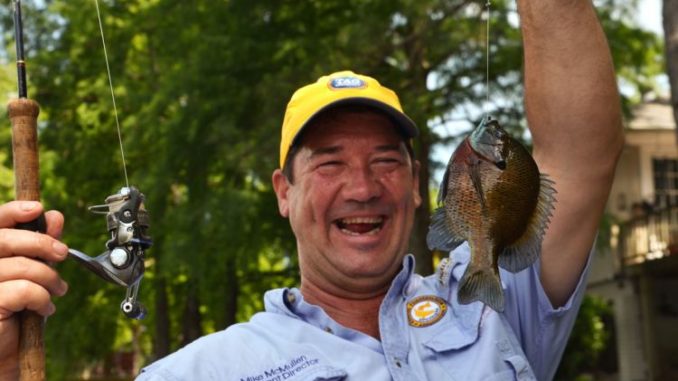
Catching big bream in an urban oasis
Um! Um! Um!
Two big ole growed up men jabbering like three-year olds over such little fish!
“I enjoy bream fishing more than any other kind,” exclaimed Mike McMullen with passion. You get a lot of action. Anywhere you want to go fishing in fresh water, you got bream!
“I think it’s better than any other fish. It’s just smaller pieces of meat.”
Brother Freddie, in a slightly less orotund approach, explained that both of them were taught to hunt and fish for anything Louisiana produced by their father Ike. But Freddie was forced to retire from his practice as a Monroe endodontist because of a broken neck.
“I was duck hunting in Mexico and one of the other hunters shot a pintail that hit me in the face. It knocked me out. The trip was a gift from my wife.
“I had a heck of a headache for 6 months. I quit working, but kept hunting and fishing. The Lord works in mysterious ways. Like Saul on the road to Damascus, I was blinded by the light.
“Seriously, that is the reason I do so much bream fishing. Fishing with heavy equipment wears me out. Even with speckled trout fishing, the beating of the boat tears me up.”
There wasn’t anything to tear up Freddie today. We were literally fishing in the backyard of his home, which fronts the bayou. This wasn’t a wilderness experience. The most expensive property in Monroe lines the bayou.
Expansive homes, manicured yards and lawns with gazebos rather than wild forest were the rule. But the scenery didn’t affect the fishing.
I knew I was in professional hands the moment I stepped into the Freddie’s boat. As they unlimbered ultralight spinning reels, Freddie explained that they prefer their use over jig poles to be able to cover more area.
“It helps to find spread-out fish. When we find a few, we anchor and catch a bunch.” Their hunting technique was simple. They poked along within casting distance of the bank using a trolling motor. When they anchored they did so with an anchor on each end of the boat to keep it in position.
When it came to baiting his hooks, Freddie was almost obsessive about hiding his hook. He wormed a wax worm on the hook first and shoved it up the shank. Then he put a live cricket on, inserting the point from the rectum and out through the insect’s collar.
“Wax worms can’t be found everywhere,” he muttered, “but I really like them. If you store them in the fridge, they will last up to 2 months. They don’t come off the hook.”
“And bream love them,” added his brother. “But I’m a cricket kind of guy. I don’t need anything more than a cricket to hide my hook.”
This may be due to the different hooks they use. Freddie’s preference is for Mr. Crappie Tru-Turn hooks and Mike’s is for Eagle Claw bait holder hooks, which have shorter shanks than do Tru-Turns.
“Any bait will hide my hook,” he grinned. It’s a stout hook, but Mike doesn’t claim to be a finesse bream fisherman. He uses braided line on his ultralight reel.
Freddie snorts in amusement at Mike’s line choice. He uses bright green, high-visibility Trilene monofilament. “It doesn’t help me see strikes; I have a cork for that. It’s for me, so I can see the line to thread a hook.”
Both men use #8 hooks, smaller than the #6 cricket hooks favored by most bream fishermen. “We started using small hooks to fish on the bottom to catch small bream for catfish bait,” explained Freddie. “We found out that they work just as good for big bull bream.
“I like the thinner wire my hook is made of because it bends easier. You can pull loose from a hang-up without disturbing a bed.
They both always fish with corks (more about that elsewhere), that they adjust to keep their baits just above the bottom. They add either one medium or two small split shot sinkers to the line just above the hook. These serve two purposes.
First, they add some weight to make casting easier. Secondly, and maybe more importantly, the cork floats upright when fishing. If the cork is laid over on its side, that means that the split shot and hook are lying on the bottom, or that a sneaky fish has picked up the bait without pulling the cork under.
As they picked and probed along the bank, they picked up oodles of less colorful female bluegills, longear sunfish (sun perch), and stumpknockers. The larger female bluegills and sun perch went straight to the ice chest, as did occasional stray non-bedding bull bluegills.
Any cast that yielded a bull was immediately followed by another one to the same spot. If it produced another big male, both anchors went down, pegging the boat in the spot.
Bigger spawning beds could yield 40 or 50 fish without moving, although 10 or 12 was the norm.
Under their expert tutoring it became easier for me to recognize “good-looking spots,” before the boat came into casting distance. Overhanging tree limbs with fringing shade in 2 to 4 feet of water were solid clues. Very often, the best spots had a few twigs, but not a treetop, sticking out of the water.
Gently sloping sand banks never held beds. Steep bluff banks dropping straight into the water were often barren as well. Best was something in between the two, with a hard clay bank and presumably a similar bottom.
But, they cautioned, it didn’t pay to pass up any stretch of bank. A hotspot that they eagerly looked forward to was in Hog Bayou, a dredged cove located downstream from the Bayou DeSiard Golf Course.
“You can always count on it for action,” bragged Freddie. “It isn’t necessarily bedded male bluegills, although you catch some there. It’s all kinds of fish.”
A more unlikely-looking spot couldn’t have existed on the whole bayou — a sterile-looking, poured concrete wall with no natural cover, edging a peninsula that jutted into the lagoon. The men moved up and down the long wall casting as close to it as possible, yanking out not only four or five species of bream, but a couple of hefty channel catfish.
Thump, thump, thump went the steady rhythm of the opening and closing of the ice chest lid. The box was relentlessly filling.
Freddie, who was operating the lid because the ice chest was closer to him, asked his brother, “you gonna clean all these?”
Mike just kept fishing. Finally when Freddie delivered the question a third time, but more forcefully, Mike leaned over from the bow, where he was operating the trolling motor.
“Oh heck, we got a lot of fish,” he deadpanned in feigned surprise.
“Yeah,” grunted Freddie. “It’s 1:05 p.m. Let’s go cook.”
An urban bayou
While Bayou DeSiard carries the name “bayou,” it is in actuality an impoundment. Its lower end was cut off from the Ouachita River in 1935 by the construction of the Ouachita River Levee System. The upper end was dammed off from Bayou Bartholomew.
It still receives some water through water control structures at Lake Bartholomew and Black Bayou Lake, as well as from Mill Bayou. The largest portion of water leaving the lake is for use as drinking water for the city of Monroe.
Bayou DeSaird is a seriously urban bayou. What isn’t flanked by expensive homes is paralleled by roads. These stretches of shoreline are heavily used by shore-bound fishermen that Freddie Miller humorously refers to as “the bucket brigade.”
Although it is giving way to residential housing, some cotton, corn, and soybean farmland is located along the northern end of the bayou. This end of the lake is studded with stands of living cypress trees, as it is shallower than the lower end.
Besides bank fishermen, the bayou turned lake receives only modest fishing pressure. “Monroe residents know that Bayou DeSaird has fish in it, but not many fish in it,” said Mike.
“Classically,” added Freddie, “the people who fish it, fish it at night for bass with a black worm.”
Some of that probably has to do with the water sports traffic. The bayou is where the University of Louisiana at Monroe (ULM) water ski team practices. “ULM has won the national water ski championship like 30 times,” boasted Freddie.
Also, every second swank house, it seems, has a ski boat, party barge, or jet ski in front of it, and many homes have their own private boat ramps.
Five public boat ramps exist on Bayou DeSaird: on Hwy. 136 near Sterlington, on Hwy. 134 at Fairbanks, at the District 2 Louisiana Department of Wildlife and Fisheries office, at the corner of Forsythe Avenue and Loop Road, and Conley’s Boat Ramp on U.S. Hwy 80.
The first four are free and the first three are concrete ramps. Conley’s Boat Launch run by big, burly and talkative John Conley has a private concrete ramp and charges a launching fee. Conley’s also has aluminum flatboats for rent and sells bait as well.
Bayou DeSaird is divided into five sections by dams that have culverts through them, according to Freddie, and not all of the sections have boat ramps. A little bit of exploring, however, revealed lots of places to launch kayaks or small boats by hand.
Bream and more
The McMullens work Bayou DeSaird hard for bream, but the bayou offers more than just bream fishing. “On a 1 to 10 scale, the bass fishing here is a 7,” said Freddie. “It has decent-sized fish — 6-pounders,” seconded Mike.
They rated the bayou’s white perch (crappie) fishing a 7 as well. One of the hotspots is beneath the big, wide Forsythe Avenue Bridge, where anglers mop up on them with jigs and shiners in late winter, peaking in February. During spawning season, March and April, fishing is best in shallow water near the bank.
The bayou offers lots of channel catfish action for fish 2 pounds and up. Trotlining and yo-yoing works well, and bream fishermen catch many of them while perch-jerking.
But bream is the star. “It’s an 8,” said Mike with a twinkle in his eye, “but most people don’t know it.”
“They don’t get real big, but they make up for it in numbers,” rumbled Freddie, perhaps with a little false modesty. Bream fishing is steady from April through August and is done in waters 3 to 4 foot deep near the bayou’s banks.
